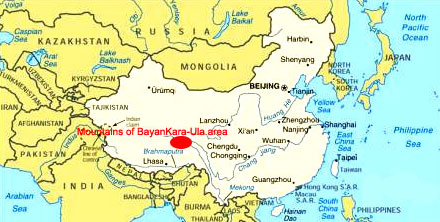|
from UFOCaseBook Website
The Hunt
An archaeological expedition, led by the highly respected Chi Pu Tei, discovered a number of unique cave burial sites. What he and his team found in these previously unknown caves would soon be considered as something highly unusual.
"click" image for larger version
For many it would represent one of the greatest discoveries of the century, and change everything they perceived about their distant past and their origins as a people.
Those who believed in the Genesis of the Bible only saw the so-called "scientific evidence" as possible proof of another creation of God intruding into Mankind's domain.
By faith, this
domain and any other living, thinking beings came from the one God
worshiped by Christian and Jew alike.
The walls were squared and glazed, as if
cut into the mountain with a source of extreme heat. Inside the
caves were several ancient, but neatly arranged burial sites, and in
them the skeletal remains of a people; a strange people.
At first it was suggested that these might be the remains of an unknown species of mountain gorilla. Fellow researchers initially ridiculed Tei's published findings. The concept of gorillas burying their young was preposterous, but that left one important question to ponder:
More discoveries made deeper in the connecting caves eliminated the possibility that apes had lived there.
On the walls carved pictograms of the heavens were found. The Earth, the sun, the moon, and the stars were there, and all were connected by pea-sized dots.
It was obvious that the pictures were meant to be a map or chart of
some kind, and that they were created by intelligent beings.
Half buried in the dirt floor of each cave they found unusual disks, originally referred to as "odd stone disks" and described as "obviously fashioned by the hand of an intelligent creature."
These disks were approximately nine inches in diameter and three-quarters of an inch thick.
In the exact center was a perfectly round 3/4 inch
hole, and etched into its face was a fine groove spiraling out from
the center to the rim, making the disk look like some kind of
"primitive phonograph record."
This was incredible news, but what was to come would be even more remarkable. A final total of 716 such plates were found, and each held its own mystery.
The
grooves, upon closer inspection, were not grooves at all, but a
continuous line of an unknown writing!
Shortly after World War II, a Polish professor named Lolladoff showed one of the 'stone disks' to British scientist Dr. Karyl Robin-Evans, who helped bring the story to the western world.
Lolladoff claimed to have bought the disk in Mussorie in Northern India and that it was supposed to be from a mysterious people called the "Dzopa" (or "Dropa") who had used it for religious rituals.
Dalai Lama with Dr. Evans
His
visit with the Dalai Lama was legendary, and provided a wealth of
information on the reclusive, unique tribe of people.
They all failed. It was not until another professor, Dr. Tsum Um Nui, broke the code and started to decipher the 'speaking grooves' that the full implications of the disc were realized. Realized, that is, only by a select few. The outside world remained in ignorance.
For the professor's conclusions on the meaning of the disc were so shattering that they were officially suppressed.
The stone disks told an astonishing story of a 'space
probe' by the inhabitants of another planet which came to crash in
the Bayan-Kara-Ula mountain range. The strange, spiral script told
how the peaceful intentions of the 'aliens' had been misunderstood,
and how many of them were hunted down and killed by members of the
Ham tribe, who lived in the neighboring caves.
According to Nui, one of the lines of the hieroglyphs read,
Another section of the writings expressed 'regret' by the Ham tribe that the aliens' spaceship had crash-landed in such a remote and inaccessible mountains and that there had been no way of building a new one to enable the Dropas to return to their own planet.
In the years since the discovery of the first disk, archeologists and anthropologists had learned more about the isolated Bayan-Kara-Ula area.
Much of
what they learned seemed to corroborate the bizarre story recorded
on the discs. Legend still preserved in the area spoke of small,
gaunt, yellow faced men who 'came from the stars, long, long ago'.
Strangely, the description of the 'invaders' tallied with the skeletons originally discovered in the caves by Professor Chi Pu Tei.
The Legend
The museum director could tell him nothing about the disks, which had begun to deteriorate, but she allowed him to touch one of them and to photograph them. He did so, but he had only a Polaroid camera with him. These photos are the ones that we see often reprinted today.
In 1994, when Hartwig Hausdorf was in
China, he asked the current director of the Banpo Museum about the
disks and was told that they had disappeared.
Today, the isolated area between Tibet and China is inhabited by two tribes of people who, in fact, call themselves the Dropa and the Ham.
Once enemies, these two
tribes now co-exist peacefully. Anthropologists have been unable to
categorize either tribe into any other known race; they are neither
Chinese nor Tibetan. Both tribes are of pygmy stature, adults
measuring between 3-foot-6 and 4-foot-7 with an average height of
4-foot-2, and body weights of 38 to 52 pounds.
Many researcher feel that the Dropa stone disks are definitive proof of an alien race that "came from the stars."
|


 The
team then made what was called "the most incredible discovery of
all."
The
team then made what was called "the most incredible discovery of
all."

